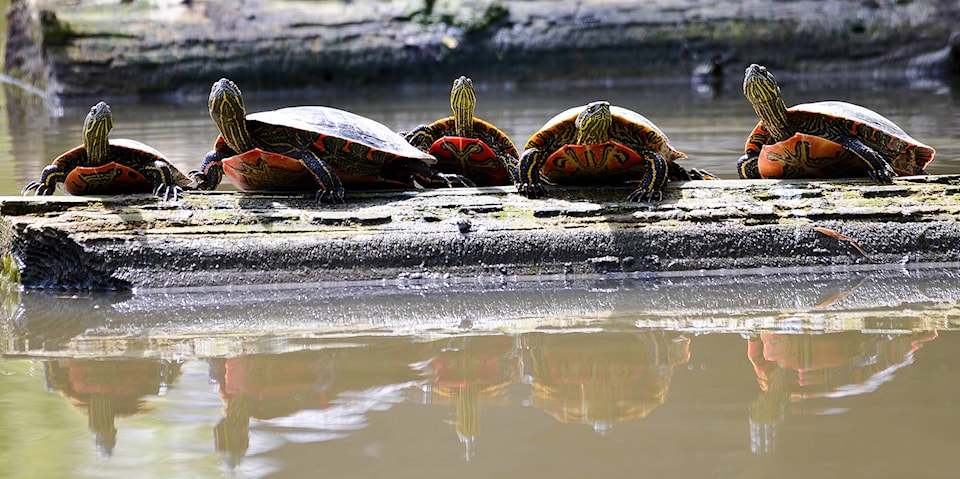A recent study has suggested measures for improving Kalavista Lagoon as a wildlife habitat.
The Society for the Protection of Kalamalka Lake (SPrKL) conducted a baseline study of the Kalavista Lagoon, a 1-acre pond across from Alexander’s Pub, in the spring, summer and fall of 2018. The results also suggest measures for improving the enjoyment of the community. Coldstream Council and staff are taking action this spring with the installation of a carp exclusion fence.
With funding of $4,390 from the Okanagan Basin Water Board (OBWB) and $14,300 from the District of Coldstream, three consulting companies voluntarily reduced their rates by 50 per cent and worked together to complete the in-depth study. Allen Hanson of Triton Environmental Consultants assessed the fish and fish habitat of the lagoon. Trina Koch and Gina LeBel of Western Water Associates conducted water quality and sediment analyses. Simone Runyan of Kestrel Ecological Consultants acted as project lead and inventoried lagoon wildlife and wildlife habitat, including aquatic and terrestrial plants, bathymetry, aquatic invertebrate sampling and adult carp enumeration.
See: Invasive species taking over Kalavista Lagoon
Caro Analytical also generously reduced their laboratory fees, and Michael Miller, Ph.D., a local plant biologist with LGL Ltd. Consulting, assisted with the identification of aquatic vegetation pro bono.
Minnow trapping and seine netting revealed an abundance of juvenile non-salmonid fish species (more than 4,300 fish from nine different species). A noteworthy capture was the chiselmouth chub, a blue-listed, or vulnerable, species known to inhabit Okanagan Lake but not previously reported in Kalamalka Lake.
Approximately 60 large common carp were observed in the lagoon in May. Common carp are an introduced species known to alter shallow lakes and ponds across North America by uprooting vegetation as they feed. The lack of plant roots to bind the sediment in the Kalavista Lagoon results in cloudy water when waves, waterfowl or carp disturb the water column.
Caro Analytical’s water quality analysis showed hyper-eutrophic water with excessive phosphorous the likely cause of algae bloom in July. High E. coli levels, especially in August, were due in part to an abundance of waterfowl. Elevated turbidity (cloudiness) in May was likely worsened by the spawning and feeding activities of carp.
Sediment cores showed that 1 to 1.5 meters of sediment had accumulated since the lagoon was created as a water feature in Coldstream’s first subdivision in the late 1940s, 70 years ago. Laboratory analyses indicated that the sediments contained levels of heavy metals above guideline thresholds, likely due to historic agricultural practices and urban contamination.
In 2017, a total of 18 western painted turtles were counted, but in 2018, only 13 turtles were counted, despite additional field visits. Western painted turtles are a blue-listed species that has lost much habitat; over 84 per cent of low elevation wetlands within the Okanagan and Similkameen Valleys have already been lost due to development. The Kalavista Lagoon has become so shallow that soon turtles may be unable to overwinter there successfully. Sediment vacuuming could be used to deepen some areas.
This spring, using a design produced by Associated Environmental Consultants and Kerr Wood Leidal Consulting Engineers, the District of Coldstream plans to install an experimental fence in the lagoon canal to prevent carp from entering the lagoon. Over a few years, aquatic plants may then regrow, stabilizing the lagoon sediment and reducing turbidity. The fence is “step one” of several possible steps including sediment removal, bank stabilization and fencing to deter geese, which could help to reduce odour and improve lagoon water quality, paddling opportunities and wildlife habitat in the lagoon.
SPrKL is interested in observing the effects of the carp exclusion fence on lagoon water quality and hopes that the fence will serve their mission: “to preserve and protect the quality and health of Kalamalka Lake Watershed for all future generations.” Funding for follow-up monitoring of lagoon water quality is being sought from the OBWB.
The Kalavista Lagoon Baseline Environmental Assessment 2018 is available in draft form as part of the District of Coldstream agenda for February 19, 2019 (Appendix F). The final report will also be available on the SPrKL website at www.spkl.ca. Please contact Simone Runyan at kestrel.ecological@gmail.com for further information.
@VernonNews
newstips@vernonmorningstar.com
Like us on Facebook and follow us on Twitter.
